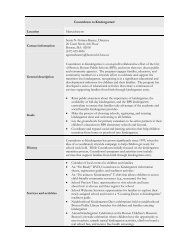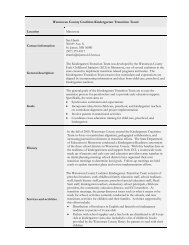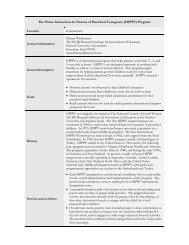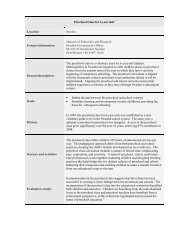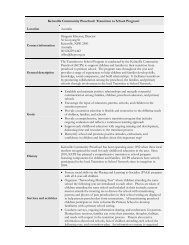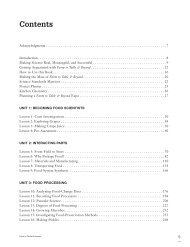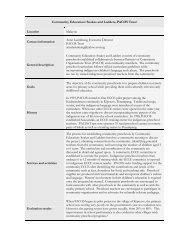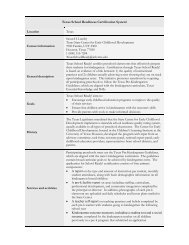Proceedings of the Fourth Annual Teachers College Educational ...
Proceedings of the Fourth Annual Teachers College Educational ...
Proceedings of the Fourth Annual Teachers College Educational ...
Create successful ePaper yourself
Turn your PDF publications into a flip-book with our unique Google optimized e-Paper software.
Online Learning Environments in Higher Education:<br />
Connectivism vs. Dissociation<br />
Sasha Reese,<br />
Indiana University <strong>of</strong> Pennsylvania, 571 Greendale Ave. Pittsburgh, PA 15218,<br />
Email: sashaconnors@yahoo.com<br />
Abstract: Over <strong>the</strong> last decade online education has emerged as ways for<br />
students and faculty to collaborate more freely, attain greater flexibility, and<br />
utilize new media to learn. The burning debate lies in whe<strong>the</strong>r online educational<br />
options are harmful to traditional education or <strong>of</strong>fer endless benefits necessary to<br />
accommodate a 21 st century learner. Supporters <strong>of</strong> virtual learning environments<br />
suggest that 21 st century learners require <strong>the</strong> construction and creation<br />
capabilities <strong>of</strong>fered through Web 2.0 to succeed while critics suggest that<br />
asynchronous interactions are not engaging and rigorous enough for higher<br />
education. A balanced online environment should provide a blend <strong>of</strong> both<br />
asynchronous and synchronous opportunities, which promote communication<br />
and collaboration among classmates and instructors.<br />
Virtual Learning in Higher Education<br />
In an effort to modernize education, many institutes <strong>of</strong> higher education have adopted online<br />
courses in fully virtual and blended formats. Fully virtual courses allow students to interact with<br />
peers and instructors solely through <strong>the</strong> use <strong>of</strong> technology, whereas blended courses use online<br />
learning as a supplement to face-to-face interactions. The current educational trend toward <strong>the</strong><br />
development <strong>of</strong> 21st century skills has made online learning attractive to both basic and tertiary<br />
education. Twenty-first century skills include, but are not limited to cultural and global awareness,<br />
self-direction, risk-taking and creativity, communication, reflection, and real world applications <strong>of</strong><br />
knowledge (Green, 2010).<br />
Controversy rests in whe<strong>the</strong>r this educational option is viable for both instructors and students.<br />
Research that supports <strong>the</strong> growth <strong>of</strong> online learning suggests that today’s learners need<br />
collaboration, freedom to create knowledge, and an au<strong>the</strong>ntic audience in order to increase<br />
engagement, participation, and activity (Rheingold, 2010). This suggests that instructors in online<br />
environments should provide students with an experience, which promotes both autonomy and<br />
community.<br />
Conversely, researchers who critic online education mention <strong>the</strong> dissociative process that can<br />
accompany virtual learning environments, and acknowledge a disconnect in <strong>the</strong> instructor and<br />
student relationship, as well as in <strong>the</strong> ability to build a learning community. Supporters <strong>of</strong> this<br />
perspective exhort that online learning must evolve from a delivery system <strong>of</strong> knowledge into a<br />
constructivist activity where learners engage in building knowledge (Hamilton, 2004, p. 843). This<br />
shift could help critics to view online schooling as a viable option.<br />
Preparing for <strong>the</strong> Future Through Connectivism<br />
Online education has emerged at universities across <strong>the</strong> country because <strong>of</strong> its ability to connect<br />
students to instructors, peers, and course content through flexible and asynchronous<br />
environments. Online learning creates a recipe <strong>of</strong> circumstances that can accommodate learners<br />
<strong>of</strong> <strong>the</strong> 21st century and <strong>the</strong>ir need for collaboration, creation, and construction (Green, 2010).<br />
According to Barbara Hoskin (2011), pr<strong>of</strong>essor at Clemson University, adult and continuing<br />
educators are leading <strong>the</strong> way from traditional education to Web 2.0 enabled education, which<br />
promotes engagement and collaboration (p. 57). A need for a pedagogical shift is evident in <strong>the</strong><br />
claim that 21st century learners also need to develop skills and competencies that will allow <strong>the</strong>m<br />
to decipher and utilize information quickly and efficiently (Siemens, 2004). Current and future<br />
university students must learn how social media literacy applies to <strong>the</strong> real world, and instructors<br />
need to begin teaching students how to use this knowledge advantageously.<br />
52



